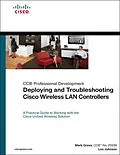This is the only complete, all-in-one guide to deploying, running, and troubleshooting wireless networks with Cisco® Wireless LAN Controllers (WLCs) and Lightweight Access Point Protocol (LWAPP)/Control and Provisioning of Wireless Access Points (CAPWAP). Authored by two of the most experienced Cisco wireless support professionals, the book presents start-to-finish coverage of implementing WLCs in existing wired and wireless network environments, troubleshooting design-related issues, and using LWAPP/CAPWAP solutions to achieve your specific business and technical goals.
One step at a time, you'll walk through designing, configuring, maintaining, and scaling wireless networks using Cisco Unified Wireless technologies. The authors show how to use LWAPP/CAPWAP to control multiple Wi-Fi wireless access points at once, streamlining network administration and monitoring and maximizing scalability. Drawing on their extensive problem-resolution experience, the authors also provide expert guidelines for troubleshooting, including an end-to-end problem-solving model available in no other book.
Although not specifically designed to help you pass the CCIE® Wireless written and lab exams, this book does provide you with real-world configuration and troubleshooting examples. Understanding the basic configuration practices, how the products are designed to function, the feature sets, and what to look for while troubleshooting these features will be invaluable to anyone wanting to pass the CCIE Wireless exams.
- Efficiently install, configure, and troubleshoot Cisco Wireless LAN Controllers
- Move autonomous wireless network solutions to LWAPP/CAPWAP
- Integrate LWAPP/CAPWAP solutions into existing wired networks
- Understand the next-generation WLC architecture
- Use Hybrid REAP and Home AP solutions to centrally configure and control branch/remote access points without deploying controllers in every location
- Use Mobility Groups to provide system-wide mobility easily and cost-effectively
- Use Cisco WLC troubleshooting tools, and resolve client-related problems
- Maximize quality in wireless voice applications
- Build efficient wireless mesh networks
- Use RRM to manage RF in real-time, optimizing efficiency and performance
- Reference the comprehensive WLC and AP debugging guide
Part of the CCIE Professional Development Series, this is the first book to offer authoritative training for the new CCIE Wireless Exam. It will also serve as excellent preparation for Cisco's new CCNP® Wireless exam.
Autorentext
Mark L. Gress, CCIE 25539, is an escalation engineer at the Cisco Systems Technical Assistance Center (TAC) in Research Triangle Park, North Carolina, where he has worked since 2005. He has been troubleshooting complex wireless networks since the birth of the Cisco Wireless LAN Controller (WLC) as a TAC engineer, a technical lead for the Enterprise Wireless team, and now as an escalation engineer supporting the complete Cisco line of wireless products. Mark has diagnosed problems in some of the largest Cisco wireless deployments and has provided training for TAC teams around the world. He has also contributed to numerous design guides, application notes, and white papers. As one of the highest contributors of identifying and assisting in defect resolution, his work has led to increases in overall product quality and stability. Mark graduated summa cum laude with a bachelors of science in both computer information systems and business management from North Carolina Wesleyan College. For more than ten years, Mark has been professionally involved in the networking industry.
Lee Johnson is currently a wireless specialist on the RTP Wireless TAC team at Cisco. He has been troubleshooting wireless networks, including both autonomous and controllerbased infrastructures, since 2006. Lee troubleshoots complex wireless issues in Cisco customer networks around the world. He has been dispatched to customer sites to address critical accounts and represented Cisco at Networkers. He also provides training and documentation for fellow Cisco engineers in both wireless and nonwireless TAC groups. Lee works closely with the wireless development group at Cisco to improve product quality and the customer experience with the WLC. He holds a bachelor of science degree in biology from the University of North Carolina at Chapel Hill.
Inhalt
Introduction xviii
Chapter 1 Troubleshooting Strategy and Implementation 1
Developing a Troubleshooting Strategy 1
Production Versus Nonproduction Outages 1
Step 1: Gathering Data About the Problem 2
Step 2: Identifying the Problem 2
Step 3: Isolating the Problem 3
Step 4: Analyzing the Data Collected About the Problem 7
Summary 9
Chapter 2 Wireless LAN Controllers and Access Points 11
Wireless LAN Controller Platforms 11
Current Production WLCs 12
Previous WLCMs 15
Functionality Differences Between WLCs 17
WLC Hardware and Software Requirements 19
Lightweight AP Models 20
Cisco Aironet APs 20
Airespace APs 25
AP 1000 Series Functionality Differences 26
AP 1000 Series Limitations 26
Lightweight Compared to Traditional Autonomous APs 28
Scalability 28
RRM 29
Self-Healing Mechanism 30
WLC Features 30
Central Management 32
Summary 35
Chapter 3 Introduction to LWAPP 37
Defining LWAPP 37
Quick Protocol Overview 38
LWAPP Advantages 41
Management 42
Scalability 42
Security 43
Mobility 43
LWAPP Mechanics 44
Discovery Process 45
Join Process 55
Image Process 56
Config State 56
Run State 57
Dissecting the Discovery Response 58
Manually Dissecting the Discovery Response 59
Summary 61
Chapter 4 The CAPWAP Protocol 63
Overview of CAPWAP 64
Differences from LWAPP 65
CAPWAP Session Establishment/AP Joining Process 67
Discovery Process 70
DTLS Session Establishment 71
Join/Config/Run 81
Troubleshooting CAPWAP Session Establishment/AP Discovery and Join 90
CAPWAP Communication: Control and Data Encryption 98
CAPWAP Communication: Sequence Numbers and Retransmissions 100
CAPWAP Fragmentation and Path MTU Discovery 101
CAPWAP-Control Packets Fragmentation 101
CAPWAP-Data Packets Fragmentation 101
CAPWAP-MTU DISCOVERY and TCP-MSS Adjustment 102
802.11 Bindings and Payloads 103
CAPWAP-Data Binding and Payloads 103
CAPWAP-Control Binding and Payloads 104
LWAPP and CAPWAP Vendor-Specific Payloads 105
Summary 105
Chapter 5 Network Design Considerations 107
Controller Placement 107
Access Layer Deployments 108
Distribution Layer Deployments 109
Service Block Deployments 109
WAN Considerations 110
AP Placement 110
Dense AP Deployment Considerations 112
802.11n 114
Location Design Considerations 116
Summary 119
Chapter 6 Understanding the Troubleshooting Tools 121
Troubleshooting on the WLC 121
Debugging 121
Advanced Debugging 126
mping and eping 131
Message Log 132
Trap Log 133
Statistics 135
Controller Statistics 135
AP Statistics 135
RADIUS Server Statistics 137
Po…
